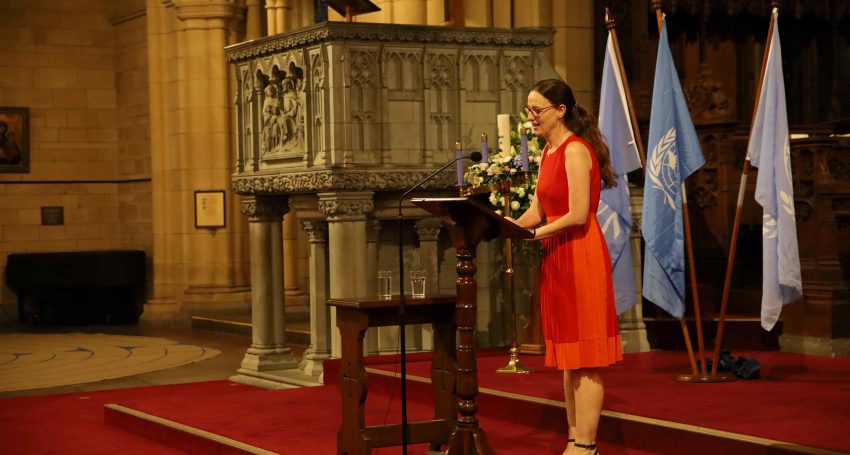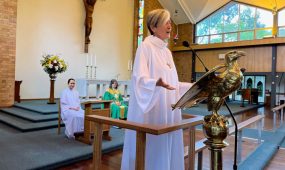Human Rights Day 2023 address
Homilies & Addresses
“In short, Australia’s pursuit of unity and prosperity and willingness to subordinate human rights to achieve those ends raises serious questions about who we are and what we value,” said Prof Renee Jeffery in her 2023 Human Rights Day address on the 75th anniversary of the Universal Declaration of Human Rights

Human rights occupy a curiously uncomfortable place in Australia’s international relations. Like liberal democracies the world over, Australia’s foreign policy is built on principles of freedom, equality, respect for democratic values, and the rule of law. As former Attorney General, George Brandis remarked at the launch of Australia’s bid for election to a coveted seat on the United Nations Human Rights Council, “commitment to human rights is essential to the very nature of what it means to be an Australian”. Human rights, he went on to say, “are integral to what we Australians regard as our sense of nationhood”. We are, he concluded “a nation built on a belief in, and a commitment to, the human rights of all, the human rights of all Australians and the human rights of all the peoples of the world”.
In one sense, this view has underpinned a foreign policy that is overtly committed to advancing human rights through multilateral institutions and bilateral dialogues, and which views human rights both as intrinsic goods and as a foundation on which peace and prosperity are built. Yet Australian foreign policy is also marked by a deep reluctance to impose values on others, to take consistent and decisive action against countries that systematically violate their populations’ human rights, or to speak up against some of the world’s most egregious abuses.
It is also a foreign policy developed in a context in which Australia is itself facing significant criticism for its own human rights record.
Australia’s most recent Universal Periodic Review in 2021 provided a decidedly mixed assessment of its human rights performance. On the positive side, the Human Rights Council Working group welcomed “progress made in the realisation of human rights” in Australia since its 2015 review. But it also raised concerns over the mandatory detention of people seeking asylum, the rights of children with regard to the age of criminal responsibility, and the rights of Indigenous people, in particular discrimination, inequality, and the high rate of incarceration among First Nations people.
Advertisement
Australia has also been reluctant to implement recommendations made by these same institutions. Less than 10 percent of recommendations made during the 2011 review process were implemented in the required timeframe. In 2015, the UN Human Rights Committee castigated Australia for its “chronic non-compliance” with the committee’s recommendations and criticised its habit of picking and choosing which international human rights laws and treaties to follow. The Committee’s vice-chair, Yuval Shany remarked in this regard that Australia’s behaviour is “incredible for a country that claims to have a leading role in global human rights”.
What explains Australia’s at times contradictory, often hypocritical, and perennially uncomfortable engagement with the global human rights regime?
I’m going to argue that much of Australia’s discomfort stems from its reluctance to address its own human rights performance or to confront its own human rights history, from its exploitation of South Sea Islander labourers and efforts to curtail non-white immigration to its treatment of its First Nations people. To do so, I’m going to briefly revisit the history of human rights in Australia and show how the pursuit of national unity (by which I mean racial unity) and especially prosperity have shaped and continue to shape its approach to human rights. Much of that history is a specifically Queensland history. It is no secret that much of our states’ human rights history is appalling. And while there is no denying or minimising that past, a perhaps lesser-known part of our history centres on those who stood up against the ill-treatment of others and, in doing so, contributed to the development of human rights in Queensland and Australia. Theirs is an important story too.
Advertisement
Although they are often considered an invention of the 1940s, by the time international community gathered in the aftermath of World War II to draft the Universal Declaration of Human Rights (1948), human rights had been a topic of discussion and debate in Australia and its colonies for more than a century.
As early as the 1830s, the term “human rights” was appearing in the Australian newspapers, casting the practice of slavery as “a violation of the most sacred and indefeasible human rights” (The Tasmanian 1838: 6) and as “an outrageous violation of human rights” (The Austral-Asiatic Review 1839: 6). Others writing in the 1830s drew on the idea of human rights to highlight injustices perpetrated against the colonies’ Indigenous populations. They not only emphasised the idea that ‘all human beings are entitled to the full rights and privileges of humanity’ but equated human rights with the avoidance and prevention of cruelty (The Colonist 1838: 2; The Perth Gazette and West Australian Journal 1836: 773). For the most part, these understandings of human rights were direct references to, and appropriations and adaptations of notions of human rights developed in the context of the anti-slavery movement, the most significant and successful human rights movement to date.
By 1859, the Sydney Morning Herald had published an article declaring that the “recognition of human rights” is a “grand event for mankind”. That idea of human rights, it continued, has “no geographical boundaries,” but rather gives to “the whole human race a more distinct sympathy with each member” (Sydney Morning Herald 1859: 4).
When the government of Queensland sat for the first time the very next year, it faced two immediate problems: a critical lack of labour and a pressing need to expand the economy beyond its reliance on the pastoral industry. The solution favoured by many was the development of a cotton industry. “Grow cotton and we will introduce capital,” its supporters argued, adding that cotton and sugar would never be grown in Queensland without the introduction of non-white indentured labour.
Others vehemently opposed the idea of importing indentured labourers and likened the practice to slavery. But such was the pull of prosperity that the demand for labour remained strong, outweighing both moral and racial concerns. In 1863, Robert Towns brought the first shipment of 67 South Sea Islanders to Queensland to work on his cotton plantation, established on land appropriated from its traditional owners along the Logan River, south of Brisbane. Within days of their arrival, Towns and his labour recruiter, Ross Lewin, were embroiled in controversy (The Courier 1863: 5). The North Australian forthrightly declared that “the slave trade had commenced in Queensland”.
Yet, with the rapid expansion of the sugar industry in northern New South Wales and Queensland, the demand for cheap labour only grew with more and more plantation owners recruiting labour from the Pacific. Lasting for more than four decades, the trade would see almost 62 500 South Sea Islanders brought to Queensland to work, primarily in the sugar and cotton industries. Most came from the Loyalty Islands (New Caledonia), the New Hebrides (now Vanuatu), and later, the Solomon Islands. While some came willingly, signing multiple contracts, traveling back and forth between Queensland and their island homes, and recommending particular employers to their family and friends, others were deceived, coerced, kidnapped, or sold.
Throughout this period, opponents of South Sea Islander labour recruitment insisted that the practice was a form of slavery and violation of fundamental human rights. In Brisbane, anti-slavery efforts were led by a small abolitionist society established by Robert Short – one of our first human rights activists. By 1867 he had made a name for himself as a vocal opponent of South Sea Islander labour recruitment, publishing regular letters in The Brisbane Courier and delivering public lectures on the subject at the School of Arts in Brisbane. The general crux of his argument was always the same: the South Sea Islander labour trade was “nothing more nor less than incipient slavery in disguise” (The Brisbane Courier 1867a: 3).
By the late 1860s Short and his colleague, William Brookes, the Member for North Brisbane, had taken his campaign to the British and Foreign Anti-Slavery Society in London. In the years that followed, its journal, the Anti-Slavery Reporter, described the Queensland labour trade as “a clandestine slave-trade” (1870: 68-70), “worse than real slavery” (1890: 183), “slavery in disguise” (1894: 24), or simply as “kidnapping” (1872: 15).
Even more significant was a series of slavery cases tried in the Queensland courts in the 1870s and 80s. The most important of these was the case of the Jason, heard at the Supreme Court in 1871. It was here that the most significant responses to the practice of blackbirding were first articulated in terms of universal rights. The case involved the alleged kidnapping of nine South Sea Islanders to be sold into servitude by the ship’s captain, John Coath. The prosecution argument rested on the idea that kidnapping was a violation of the universally-held right to liberty. Chief Justice Cockle and Justice Lutwyche both agreed. In his judgment, Cockle equated the labour trade with slavery and warned that its continuation would give Queensland an international reputation as a place where the violations of rights could be perpetrated with impunity. This would, he argued, endanger its commercial interests. That is, to a legal argument about rights, an appeal to the continued prosperity of the colony was added.
Yet, it was Justice Lutwyche’s judgment that, for the first time, cemented the place of liberty in Australia’s understanding of the principle on which its engagements with foreign peoples ought to be conducted. “[W]hether they are civilised or not matters not,” Lutwyche wrote, “they have a right to liberty, which is inherent in all human beings”. As Mortensen notes, it was “a singular precedent” that would later form part of Chief Justice Lilley’s judgment in the 1884 case of the Hopeful. That case saw the recruiting agent, Neil McNeil and boatswain, Barney Williams, tried for the murder of a man named Tenepapa at Harris Island (now part of Papua New Guinea) and the kidnapping of eight others. Drawing on Lutwyche’s argument about universal human rights in his instructions to the jury, Judge Lilley implored the jurors to put aside the widely-held belief that “the life of a black man was of little importance”. Both were found guilty and sentenced to be hanged. Three days later, five others implicated in the atrocities were tried, found guilty, and sentenced to hard labour, with the first three years to be spent in irons. After a significant public backlash all the sentences were commuted, but the point had been made and the precedent set: fundamental human rights were universally held. They applied, not just to the white-settler population of the colonies, but to those with whom they engaged from other parts of the world.
While persistent efforts by humanitarians led to increased regulation, the end of the Pacific Island labour trade came, not as the result of humanitarian concern or the adoption of universal principles of human rights in Australia, but as the result of the White Australia Policy. In short, issues of race even trumped arguments about the economic benefits of indentured labour for the Queensland sugar industry and saw rights arguments deliberately put aside.
This story is not simply an issue of historical interest; it is also one of contemporary importance. Deeply embedded in Australia’s engagement with human rights – baked-in, if you like, over two hundred years – unity and prosperity continue to mark its foreign policy: the 2017 Foreign Policy White Paper references prosperity a staggering 87 times. It tells us that human rights are to be valued because they “underpin peace and prosperity”. While the paper professes Australia’s commitment to “advancing human rights globally,” the value proposition is posed in terms of stability, security, and prosperity.
And while the term unity has been replaced by the idea of social cohesion and coupled with multiculturalism, its close relationship to prosperity remains unchanged. The White Paper tells us that “[b]y generating more and better paying jobs, a strong and flexible economy reinforces the social cohesion and resilience of Australian society”. It also continues to inform Australia’s approach to issues of migration and criticisms of its treatment of people seeking asylum: “Without a well-managed migration program,” the White Paper explains, “the cohesion of our society could be damaged and community support for our humanitarian program would be unsustainable”. This argument was replicated in Australia’s response to the 2020 Universal Periodic Review and used to reject calls for it to bring its asylum seeker policies in line with its obligations under the Refugee Convention.
In short, Australia’s pursuit of unity and prosperity and willingness to subordinate human rights to achieve those ends raises serious questions about who we are and what we value. And just as those early activists of the 19th century sought to challenge dominant views of human rights at the time, so too, our contemporary society relies on the work of organisations such as this, and the efforts of people like you, to continue speaking up for the marginalised and dispossessed, to keep human rights on the agenda, and to fight for the dignity and rights of all.
Editor’s note: Listen to Prof Renee Jeffery’s Human Rights Day address on St John’s Cathedral YouTube.





